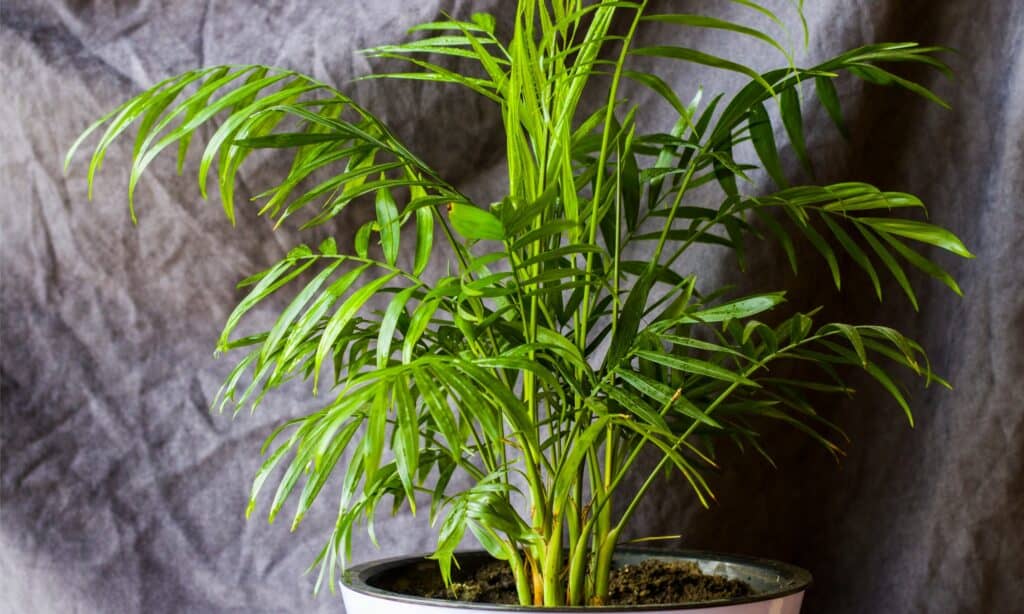Given just how many palm tree varieties there are in the world today, you may be wondering what the differences are between a cat palm versus areca palm. How are these two palm trees similar, and how are they different? What can you use to tell them apart, and which palm tree variety might be right for your backyard landscaping or indoor house plant display?
In this article, we will compare and contrast the areca palm with the cat palm so that you can understand them both as individual species. We will address what they look like physically as well as what they are typically used for, and even where these two varieties originated. Let’s get started and talk all about palm trees now!
Comparing Cat Palm vs Areca Palm

| Cat Palm | Areca Palm | |
|---|---|---|
| Classification | Chamaedorea cataractarum | Dypsis lutescens |
| Description | Grows in clustered stalks rather than one central trunk. Leaves are grown close to one another, with lush fronds in dark green shades. Can look extremely full if left untrimmed. Reaches 6-8 ft tall outdoors and a diminutive 4 ft tall indoors | Resembles bamboo in color and the way that it grows, with ribbon-like leaves and trunks that can turn golden yellow in color. When grown indoors, this palm can reach 8 ft tall, but grows much larger outside. Leaves spread wide and tall, with multiple clusters growing side by side |
| Uses | Small sizes makes it perfect for indoor plant displays, and it is attractive in color | Moderate growth rate is above average for other palm species, and it makes a great privacy plant when grown outside. |
| Origin and Growing Preferences | Originally found in Central America and Mexico; enjoys bright indirect sun, both indoors and out. Struggles with dry soil, so be sure to water regularly! | Originally found in Madagascar; enjoys direct, bright light to some shade. Make sure to not overwater, and filtered water or rainwater is preferred! |
| Special Features and Fun Facts | This plant grows in a unique way that helps it avoid getting washed away by water! | Technically endangered in Madagascar, but grown in many locations in the United States! |
Key Differences Between Cat Palm vs Areca Palm

The cat palm originated in Central America and Mexico, while the areca palm originated in Madagascar.
©iStock.com/Tamar Dundua
There are a number of key differences between the cat palm and the areca palm. For example, areca palm trees grow much larger than cat palm trees, both indoors and out. In addition, the leaves found on the cat palm are much greener in color compared to the yellowish green leaves found on the areca palm. Finally, the cat palm originated in Central America and Mexico, while the areca palm originated in Madagascar.
Let’s go over all of these differences in more detail now.
Cat Palm vs Areca Palm: Classification

Cat palm trees have leaves in deep green shades, while areca palm trees have leaves that turn yellow, and their stems can also have yellow on them.
©Danita Delimont/Shutterstock.com
While they are both members of the same family, the cat palm and the areca palm have different genus and species classifications from one another. This may come as a surprise, especially when you consider just how similar in appearance both of these palm trees are. Taking a closer look, the cat palm can be classified as Chamaedorea cataractarum, while the areca palm can be classified as Dypsis lutescens.
Cat Palm vs Areca Palm: Description
It can be incredibly difficult to tell the difference between a cat palm and areca palm just by looking at them. Overall however, areca palm trees grow far larger than cat palm trees, both indoors and out. In addition, cat palm trees have leaves in deep green shades, while areca palm trees have leaves that turn yellow, and their stems can also have yellow on them.
Both of these palm tree varieties grow in clustered stalks that resemble bamboo in the way that they grow, though the cat palm tree has denser appearance on average compared to the areca palm tree. Even though they are technically both palm trees, neither of these plants grows with a centralized trunk!
Cat Palm vs Areca Palm: Uses

Areca palms are ideal when used as privacy borders or shade outdoors, while cat palm trees remain small and ornamental given their size.
©iStock.com/dropStock
Given that they grow in a similar way, both cat palm trees and areca palm trees are popular when used as either indoor or outdoor plants. However, cat palm trees are used for their small size, while areca palm trees grow much larger. This makes areca palms ideal when used as privacy borders or shade outdoors, while cat palm trees remain small and ornamental given their size.
Cat Palm vs Areca Palm: Origin and How to Grow
Both areca palms and cat palms have similar care, given their relation to one another and the types of plants that they are. However, cat palm trees enjoy bright indirect light, while areca palm trees can handle some level of shade. Both of these plants need well-draining soil, though the cat palm tree prefers a certain level of moisture in its soil compared to the areca palm. Be sure to never over water either of these two plants, but the areca palm can dry out a bit more frequently than the cat palm.
Cat Palm vs Areca Palm: Special Features

Cat palm trees enjoy bright indirect light, while areca palm trees can handle some level of shade.
©Vipul1989/Shutterstock.com
The cat palm and the areca palm are special for a number of reasons, especially when it comes to where you choose to plant them and what you choose to do with them. The areca palm originated in Madagascar, though it is considered an endangered species there to this day. The cat palm is unique in that it grows in a certain way to help it from being washed away in major flooding scenarios or overwatering. Deep roots grow throughout the soil, though this may make the cat palm susceptible to disease.
Up Next:
- Coconut Tree vs. Palm Tree: 5 Key Differences
- Areca Palm vs. Majesty Palm: What’s the Difference?
- Parlor Palm vs. Areca Palm: What’s the Difference?
The photo featured at the top of this post is © iStock.com/Tamar Dundua
Thank you for reading! Have some feedback for us? Contact the AZ Animals editorial team.






